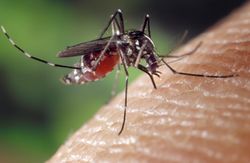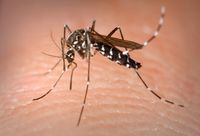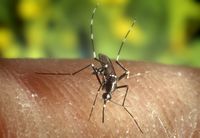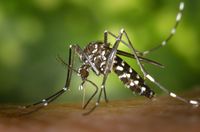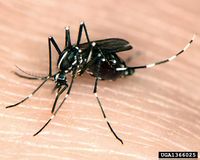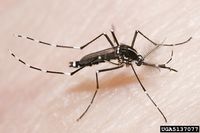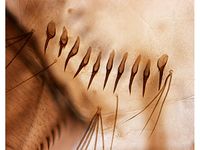Difference between revisions of "Aedes albopictus"
| Line 2: | Line 2: | ||
{{LiteratureDB|{{PAGENAME}}|browse,benefialsN}} | {{LiteratureDB|{{PAGENAME}}|browse,benefialsN}} | ||
[[File:Aedes albopictus on human skin.jpg|250px|thumb|''Aedes albopictus'' feeding on a human host<br/>Source: [http://commons.wikimedia.org/wiki/File:Aedes_albopictus_on_human_skin.jpg Wikimedia Commons]]] | [[File:Aedes albopictus on human skin.jpg|250px|thumb|''Aedes albopictus'' feeding on a human host<br/>Source: [http://commons.wikimedia.org/wiki/File:Aedes_albopictus_on_human_skin.jpg Wikimedia Commons]]] | ||
| − | <font color="#800000">'''''Aedes albopictus'''''</font> (Skuse) - (Asian tiger mosquito) | + | <font color="#800000">'''''Aedes albopictus'''''</font> (Skuse) - (Asian tiger mosquito) |
| + | |||
The mosquito is an aggressive, human-biting mosquito, closely associated with the human environment where it usually breeds in containers, water-storage tanks or other sources of stagnant water around houses. It is native to Asia and has spread to Africa, America and Europe. It is found since 1986 in North America. South America has been invaded around the same time and since 1987 it has been also reported from Europe. Since it can lay diapausing eggs it survives even in colder regions. | The mosquito is an aggressive, human-biting mosquito, closely associated with the human environment where it usually breeds in containers, water-storage tanks or other sources of stagnant water around houses. It is native to Asia and has spread to Africa, America and Europe. It is found since 1986 in North America. South America has been invaded around the same time and since 1987 it has been also reported from Europe. Since it can lay diapausing eggs it survives even in colder regions. | ||
| Line 18: | Line 19: | ||
For details see the respective page in [[wikipedia:Aedes albopictus|Wikipedia]]. | For details see the respective page in [[wikipedia:Aedes albopictus|Wikipedia]]. | ||
| + | |||
<gallery widths=200px caption="Other images of Aedes albopictus (Wikimedia Commons, PaDIL and IPM Images - click to enlarge)"> | <gallery widths=200px caption="Other images of Aedes albopictus (Wikimedia Commons, PaDIL and IPM Images - click to enlarge)"> | ||
Revision as of 19:49, 23 July 2015
| Literature database |
|---|
| 1812 articles sorted by: |
| • year (recent ones first) |
| • research topics |
| • countries/regions |
| • list of natural enemies |
Aedes albopictus (Skuse) - (Asian tiger mosquito)
The mosquito is an aggressive, human-biting mosquito, closely associated with the human environment where it usually breeds in containers, water-storage tanks or other sources of stagnant water around houses. It is native to Asia and has spread to Africa, America and Europe. It is found since 1986 in North America. South America has been invaded around the same time and since 1987 it has been also reported from Europe. Since it can lay diapausing eggs it survives even in colder regions.
A study in New Jersey (U.S.A.) showed that in urban areas Ae. albopictus feeds exclusively on mammalian hosts with over 90% of their blood meals derived from humans and domesticated pets (Faraji et al., 2014). It is an efficient vector of dengue fever. It also transmits yellow fever, various types of encephalitis, dog heartworm (Dirofilaria immitis) and other diseases (e.g. chikungunya viruses). Vector control is often the only or the most appropriate method to combat these diseases.
| Vernacular names | |
|---|---|
| • Deutsch: | Asiatische Tigermücke |
| • English: | Asian tiger mosquito |
| • Español: | mosquito tigre |
| • Français: | moustique-tigre |
It bites during the day and protection by insecticide-treated bed nets is not applicable to this species. The adult is about 4 mm long, but can vary considerably in size. It can be distinguished from Aedes aegypti by a single, white dorsal stripe on the thorax. The development time from egg hatching to adult emergence is around 2-3 weeks, depending on the temperature.
Synonyms:
Stegomyia albopictus
For details see the respective page in Wikipedia.
- Other images of Aedes albopictus (Wikimedia Commons, PaDIL and IPM Images - click to enlarge)
